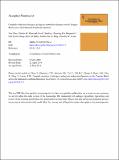Files in this item
Coupled evolution of nitrogen cycling and redoxcline dynamics on the Yangtze Block across the Ediacaran-Cambrian transition
Item metadata
| dc.contributor.author | Chen, Yan | |
| dc.contributor.author | Diamond, Charles W. | |
| dc.contributor.author | Stüeken, Eva E. | |
| dc.contributor.author | Cai, Chunfang | |
| dc.contributor.author | Gill, Benjamin C. | |
| dc.contributor.author | Zhang, Feifei | |
| dc.contributor.author | Bates, Steve M. | |
| dc.contributor.author | Chu, Xuelei | |
| dc.contributor.author | Ding, Yi | |
| dc.contributor.author | Lyons, Timothy W. | |
| dc.date.accessioned | 2020-05-17T23:34:18Z | |
| dc.date.available | 2020-05-17T23:34:18Z | |
| dc.date.issued | 2019-05-18 | |
| dc.identifier | 259078445 | |
| dc.identifier | 361b2d0d-85f9-441f-a37f-eac757b3c9fa | |
| dc.identifier | 85066100614 | |
| dc.identifier | 000470830800016 | |
| dc.identifier.citation | Chen , Y , Diamond , C W , Stüeken , E E , Cai , C , Gill , B C , Zhang , F , Bates , S M , Chu , X , Ding , Y & Lyons , T W 2019 , ' Coupled evolution of nitrogen cycling and redoxcline dynamics on the Yangtze Block across the Ediacaran-Cambrian transition ' , Geochimica et Cosmochimica Acta , vol. In press . https://doi.org/10.1016/j.gca.2019.05.017 | en |
| dc.identifier.issn | 0016-7037 | |
| dc.identifier.other | RIS: urn:235A5CDF6F4C5A5BF8BD12AA47DC26BC | |
| dc.identifier.other | ORCID: /0000-0001-6861-2490/work/65014420 | |
| dc.identifier.uri | https://hdl.handle.net/10023/19955 | |
| dc.description | The authors acknowledge funding support from the NSF FESD and Earth-Life Transitions programs (T.L.), the NASA Astrobiology Institute under Cooperative Agreement No. NNA15BB03A issued through the Science Mission Directorate (T.L.), the key project of the Natural Science Foundation of China (C.-F.C.) (No. 41730424), and the program of China Scholarships Council (Y.C.) (No. 201504910582). Nitrogen and carbon isotope analyses were funded by startup funds from Virginia Tech to B.C.G. | en |
| dc.description.abstract | The Ediacaran-Cambrian transition is characterized by the evolution of complex eukaryotes and rapid diversification of metazoans. However, linkages between environmental triggers and evolutionary patterns remain unclear. Here, we present high-resolution records of carbon and nitrogen isotopic data (δ13C, δ15N) for a drill core extending from the early Ediacaran Doushantuo Formation to the early Cambrian Jiumenchong Formation, located on the slope of the Yangtze Block. Our data show that sedimentary bulk nitrogen isotope values (δ15Nbulk) decrease progressively from the early Ediacaran to the early Cambrian, broadly concurrent with nitrogen isotope data from other sections throughout the Yangtze Block. During the early Ediacaran, however, δ15Nbulk values from our study are higher (maximum 11.2‰) compared to those from more restricted coeval sections, suggesting a higher degree of denitrification in our slope section. The early Ediacaran δ15Nbulk data from the Yangtze Block may thus provide indirect evidence for an upwelling system that led to a shallower redoxcline in slope environments of the Upper Yangtze region. Widespread light δ15Nbulk values from the early Cambrian (minimum −7.5‰) paired with excess silicate-bound nitrogen throughout much of the Yangtze Block are most parsimoniously interpreted as non-quantitative assimilation of ammonium (NH4+) with relatively high concentrations of NH4+ accumulating in the deep basin. Overall, the spatial and temporal trends in nitrogen cycling across the Yangtze Block suggest that fixed nitrogen was more bioavailable in the Ediacaran-Cambrian Yangtze Basin compared to previously studied Mesoproterozoic sections, although nitrogen speciation in the photic zone may have varied with time. Environmental factors such as oxygen levels and nitrogen bioavailability may have shaped the evolutionary trajectory of life on the Yangtze Block and potentially elsewhere across the Ediacaran-Cambrian transition. | |
| dc.format.extent | 4596764 | |
| dc.language.iso | eng | |
| dc.relation.ispartof | Geochimica et Cosmochimica Acta | en |
| dc.subject | Ediacaran | en |
| dc.subject | Cambrian | en |
| dc.subject | Yangtze Block | en |
| dc.subject | Nitrogen cycling | en |
| dc.subject | Redoxcline | en |
| dc.subject | Ammonium | en |
| dc.subject | GE Environmental Sciences | en |
| dc.subject | DAS | en |
| dc.subject.lcc | GE | en |
| dc.title | Coupled evolution of nitrogen cycling and redoxcline dynamics on the Yangtze Block across the Ediacaran-Cambrian transition | en |
| dc.type | Journal article | en |
| dc.contributor.institution | University of St Andrews. School of Earth & Environmental Sciences | en |
| dc.contributor.institution | University of St Andrews. St Andrews Centre for Exoplanet Science | en |
| dc.identifier.doi | https://doi.org/10.1016/j.gca.2019.05.017 | |
| dc.description.status | Peer reviewed | en |
| dc.date.embargoedUntil | 2020-05-18 |
This item appears in the following Collection(s)
Items in the St Andrews Research Repository are protected by copyright, with all rights reserved, unless otherwise indicated.

